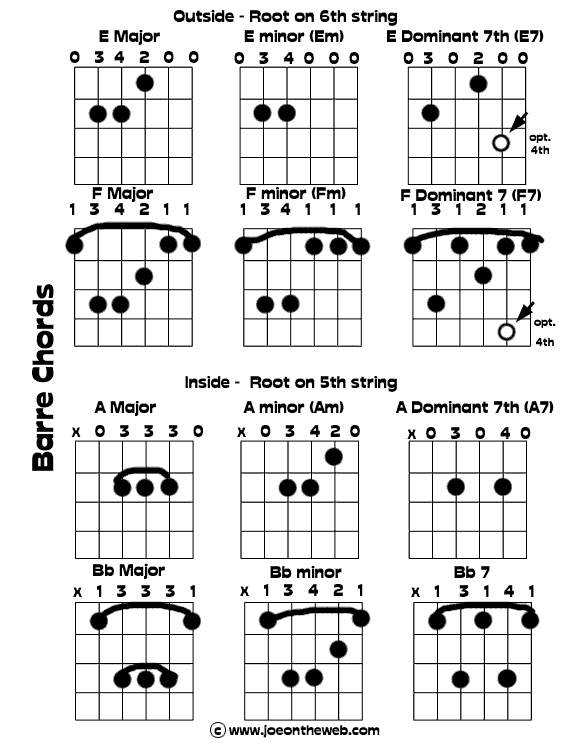
Barre Chords
Who would think you could learn 36 chords in a few moments? Well think again. How about learning 72 chords? Now get your 6 stringer and follow along. You may want to print the illustration below to help you put this to work. Just (right click) on the Barre Chord picture below and select print. Take a simple E chord as shown in the illustration below and instead of using your 1st, 2nd and 3rd finger to play the chord we will use the 2nd, 3rd, and 4th fingers as shown. The 2nd finger is on the 1st fret of the 3rd string. The 3rd finger is on the 2nd fret of the 5th string, and the 4th finger is on the 2nd fret of the 4th string. This allows us to use our 1st finger to Barre across all of the strings. So, if we play the E chord and move it up to the 2nd fret and put the 1st finger as a Barre across the 1st fret, we now have an F chord. The (root) or name of the chord comes from the 6th string. We will call this an outside chord, because the name comes from the outside (6th) string.
Moving that same fingering to the 2nd fret gives us a F# chord.
The same fingering at the 3rd fret makes a G chord.
Move it to the 5th fret it is now an A chord.
We should at this point realize that with 12 frets, we are capable of playing 12 chords, with this one fingering. Not bad huh? Just remember that between E and F and B and C there is only (1/2 step) one fret. All other natural notes/chords are (a whole step) or two frets on the guitar. The frets in between are sharp or flat chords.
So the order of chords based on the 6th string root are:
E - open
F - 1st fret
F# or Gb - 2nd fret
G - 3rd fret
G# or Ab - 4th fret
A - 5th fret
A# or Bb - 6th fret
B - 7th fret
C - 8th fret
C# or Db - 9th fret
D - 10th fret
D# or Eb - 11th fret
E - 12th fret
Once again we will refer to these as Outside Barre chords as their name comes from the 6th (or outside) string. So far we have 12 chords right?
How about that E Dominant 7th chord (E7) we make by taking away the 4th finger from the Major chord. Yup, you guessed it 12 more chords. 1st fret being F7, 2nd is F#7, 3rd is G7 and so-on up the fretboard. Also note that there is an optional 4th finger you could use for a different sound. Try it. Now how many chords did we learn? I think the count is now at 36 chords.
Now that we have completed the "Outside Barre Chords", It's time to roll up our sleves and work on the "Inside Barre chords". Looking at our diagram above, you may notice I chose to play the A Major chord using the 3rd finger laying down to cover the 4th, 3rd, and 2nd strings. We do this again to open up our 1st finger to use as a barre. Slide the A major chord up 1 fret and add the 1st finger as a barre on the 1st fret. Now we have an A# or Bb chord. As in our other exersizes we can move that to the 2nd fret to make B Major then the 3rd fret to make C major. The pattern of 1/2 steps and whole steps applies to this also.
A - open
A# or Bb - 1st fret
B - 2nd fret
C - 3rd fret
C# or Db - 4th fret
D - 5th fret
D# or Eb - 6th fret
E - 7th fret
F - 8th fret
F# or Gb - 9th fret
G - 10th fret
G# or Ab - 11th fret
A - 12th fret
Guess what . . . 12 more chords added to our vocabulary. By now, I think you can see the pattern that occurs. Use the A minor fingering and move it up one fret and add the barre. Wha-la! Bb minor at the first fret. Then B minor at the 2nd fret. C minor at the 3rd and so on and so on. 12 more chords! Yes, yes now the dominant 7th also will do the same routine.
A7 open
A#7 or Bb7 - 1st fret
B7 - 2nd fret
C7 - 3rd fret
C#7 or Db7 - 4th fret
D7 - 5th fret etc, etc.
Now we have a total of 72 chords. Wow! We should be able to play alot of tunes with them.
Some chord exersizes are coming soon to put all of these babies to work for you. For now just practice playing each form up and down the fretboard. Try to memorize where all the Major, Minor and Dominant 7th chords are, Inside and Outside. Later we will work on moving from inside to outside and outside to inside forms to make changing from one chord to the next a little easier.
Copyright
2005 © Joe Weinman on the web
www.Joe on the Web.com